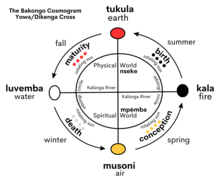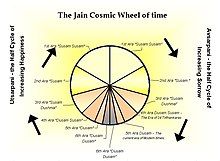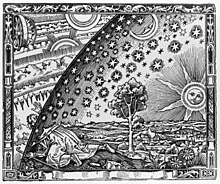Wheel of time
This article needs additional citations for verification. (January 2008) |
The wheel of time or wheel of history (also known as Kalachakra) is a concept found in several religious traditions and philosophies, notably religions of Indian origin such as Hinduism, Jainism, Sikhism, and Buddhism, which regard time as cyclical and consisting of repeating ages. Many other cultures contain belief in a similar concept: notably, the Q'ero people of Peru, the Hopi people of Arizona, and the Bakongo people of Angola and Democratic Republic of the Congo.
Ancient Africa

In traditional
- Mbûngi represents aether and is the void that exists before creation.
- Musoni time (South) represents air and is the period of conception that takes place during spring.
- Kala time (East) represent fire and is the period of birth that takes place during summer.
- Tukula time (North) represents earth and is the period of maturity that takes place during fall.
- Luvemba time (West) represents water and is the period of death that takes place during winter.
Ancient Rome
The philosopher and emperor Marcus Aurelius saw time as extending forwards to infinity and backwards to infinity, while admitting the possibility (without arguing the case) that "the administration of the universe is organized into a succession of finite periods".[2]: Book 5, Paragraph 13
Buddhism
The
tradition.The Kalachakra tantra prophesies a world within which (religious) conflict is prevalent. A worldwide war will be waged which will see the expansion of the mystical Kingdom of Shambhala led by a messianic king.
Hinduism
In
Jainism

Within
Modern usage
Literature
In an interview included with the audiobook editions of his novels, author Robert Jordan has stated that his bestselling fantasy series The Wheel of Time borrows the titular concept from Hindu mythology.[6]
The first chapter of every book in the series begins with the lines: "The Wheel of Time turns, and ages come and pass, leaving memories that become legend. Legends fade to myth, and even myth is long forgotten when the Age that gave it birth comes again." [7]
Television
- Several episodes of the American TV series Lost feature a wheel that can be physically turned in order to manipulate space and time. In a series of episodes during the fifth season, the island on which the show takes place begins to skip violently back and forth through time after the wheel is pulled off its axis.
- The character Rust Cohle in the first season of True Detective makes numerous references to his belief that events in time repeat, claiming that "Time is a flat circle".

See also
References
- ISBN 978-1-890157-28-9.
- OCLC 757023454.
- OCLC 501804251.
- OCLC 91697.
- OCLC 71358145.
- ^ "Robert Jordan chats about his 'Wheel of Time' series". CNN. Retrieved 14 June 2017.
- ISBN 978-0-356-50382-0.
- Sources
- Jordan, Robert (1990). The eye of the world. New York: T. Doherty Associates. ISBN 0-312-85009-3.
